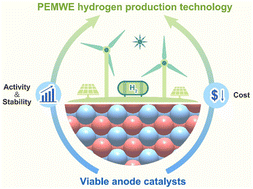Advances and status of anode catalysts for proton exchange membrane water electrolysis technology
Abstract
Coupling renewable electricity with proton exchange membrane water electrolysis (PEMWE) technology to generate decarbonized “green hydrogen” is a key route for the international “carbon neutrality” target. Large-scale applications of PEMWE hydrogen production technology urgently demands low-cost, efficient, and robust anode catalysts, which are competent to industrial requirements. In this review, the developments and status of anode catalysts for PEMWE are systematically summarized. We start by introducing the stack structure and principle of the PEM electrolyzer, mechanism of oxygen evolution reaction (OER) in acid, and activity–stability trade-off of anode catalysts. Then, an overview of reported anode materials, such as Ir-based catalysts, Ru-based catalysts, and noble-metal-free catalysts, is provided. Considering the fact that the superior activity and stability of anode catalysts evaluated in the laboratory are rarely rendered to high performance under industrial conditions, we discuss the inherent reasons for the discrepancy in performance between the two test systems, i.e., the three-electrode cell set-up and PEM electrolyzer. Subsequently, the strategies for designing viable anode catalysts as well as intermediate assessment methods for narrowing the gap between efficient anode materials and high-performance PEM electrolyzers are provided. Finally, we explore the future direction of developing viable anode catalysts for PEMWE hydrogen production technology.

- This article is part of the themed collections: 2023 Materials Chemistry Frontiers Review-type Articles and Materials Chemistry Frontiers Most Popular Articles 2023


 Please wait while we load your content...
Please wait while we load your content...